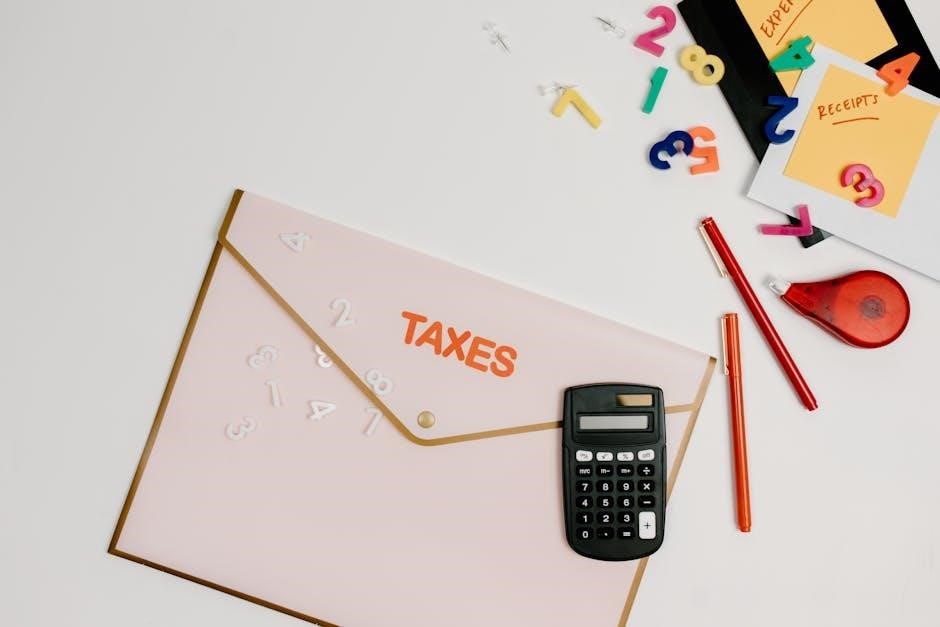The Bill of Rights Scenarios Worksheet is an educational tool designed to help students understand the first 10 Amendments through real-life situations and court cases. It provides practical examples to apply constitutional rights, making learning interactive and engaging for better comprehension of individual freedoms and governmental limitations.
Overview of the Bill of Rights
The Bill of Rights, comprising the first 10 Amendments to the U.S. Constitution, was ratified in 1791 to safeguard individual liberties and limit governmental power. These amendments guarantee fundamental freedoms such as religion, speech, press, assembly, and the right to bear arms. They also establish protections against unreasonable searches, ensure due process, and uphold the right to a fair trial. The Bill of Rights was crafted to address concerns about federal authority, ensuring that citizens’ rights are protected from infringement. It serves as a cornerstone of American democracy, balancing individual freedoms with governmental responsibilities. The amendments are concise yet profound, providing a framework for civil liberties that remains vital today. Understanding the Bill of Rights is essential for grasping the principles of constitutional law and the rights it affords to all Americans.
Purpose of the Scenarios Worksheet
The purpose of the Bill of Rights Scenarios Worksheet is to provide an interactive and engaging way for students to learn about and apply the principles of the first 10 Amendments. By presenting real-life situations, the worksheet helps students connect theoretical knowledge with practical examples, fostering critical thinking and a deeper understanding of constitutional rights. Each scenario is designed to challenge students to identify potential violations of specific amendments, encouraging them to analyze the context and apply relevant legal concepts. This educational tool also aims to promote discussions about the importance of civil liberties and how they impact everyday life. The worksheet is particularly useful in classroom settings, as it offers a hands-on approach to learning about the Bill of Rights and its modern-day applications. Through this resource, students gain a clearer appreciation of the rights guaranteed by the Constitution and how they are upheld in society.

Understanding the Structure of the Worksheet
The worksheet is structured as a PDF document containing 10 scenarios, each illustrating potential violations of specific Bill of Rights amendments, along with relevant court cases for educational analysis and discussion purposes.
Format and Layout of the PDF Document

The Bill of Rights Scenarios Worksheet PDF is designed to be user-friendly and organized for easy navigation. Each scenario is presented on a separate page, with clear headings and concise descriptions. The document includes sections for identifying which amendment is relevant, analyzing potential violations, and referencing landmark court cases. The layout features bullet points and numbered lists to enhance readability, while bold headings distinguish different sections. Spaces for answers are provided for interactive learning. Visual elements, such as icons or images, may be included to supplement understanding. The PDF is structured to guide students through critical thinking about constitutional rights, making it an effective tool for educational purposes.
How to Use the Worksheet for Educational Purposes
The Bill of Rights Scenarios Worksheet PDF is a versatile educational resource designed to engage students in active learning. Educators can use it to teach the Bill of Rights by assigning scenarios as homework or in-class activities. For each scenario, students match the situation to the relevant amendment and determine if a rights violation occurred. Teachers can facilitate group discussions or debates to encourage critical thinking about constitutional principles. The worksheet can also be paired with court case analyses to deepen understanding of legal precedents. Additionally, educators can create quizzes or assessments based on the scenarios to evaluate student comprehension. Visual aids, such as charts or flowcharts, can complement the worksheet to help students organize their thoughts. By integrating this resource into lesson plans, teachers can create an interactive and meaningful learning experience that aligns with curriculum standards and promotes civic literacy.

Amendments and Their Relevance to the Scenarios
The Bill of Rights Scenarios Worksheet connects each amendment to real-life situations, helping students understand how constitutional rights apply in practical contexts and modern challenges.
1st Amendment Scenarios: Freedom of Speech and Religion

The 1st Amendment guarantees freedoms of speech, religion, press, assembly, and petition. Scenarios explore these rights in real-life contexts, such as students wearing armbands to protest a war, sparking debates on symbolic speech. Courts have ruled that schools can regulate speech if it disrupts learning, but students retain expressive rights. Another scenario involves a city ordinance banning religious symbols on public property, testing the separation of church and state. These exercises help students grasp how the 1st Amendment balances individual liberties with societal norms, preparing them to analyze modern issues like censorship, protest rights, and religious freedom. By engaging with these situations, learners develop critical thinking skills to apply constitutional principles in everyday life and understand the complexities of protecting these fundamental rights in a diverse society.
2nd Amendment Scenarios: Right to Bear Arms

The 2nd Amendment, guaranteeing the right to bear arms, is explored through scenarios that test its interpretation. For instance, a city bans handguns, prompting questions about whether this infringes on citizens’ rights. Another scenario involves a state requiring permits for rifle ownership, sparking debates on reasonable regulations. These exercises help students analyze how courts balance individual rights with public safety concerns. Historical cases, like District of Columbia v. Heller, are often referenced to illustrate judicial interpretations. By engaging with these real-world examples, learners develop a deeper understanding of the complexities surrounding firearm laws and the constitutional protections in place. This section encourages critical thinking about the role of government in regulating weapons while safeguarding citizens’ liberties.
3rd Amendment Scenarios: Protection from Quartering Soldiers
The 3rd Amendment protects citizens from being forced to house soldiers in peacetime without consent. Scenarios in the worksheet explore this right through hypothetical situations, such as a local government requiring residents to accommodate National Guard troops during a disaster drill. Students must determine if this action violates the amendment. Another scenario involves a homeowner refusing to allow military personnel to stay, prompting a legal challenge. These exercises highlight the amendment’s purpose of safeguarding personal property rights. Historical context, like colonial-era quartering practices, is often included to provide background. The worksheet also references court cases, such as United States v. New York, to show how courts have interpreted this amendment. By analyzing these scenarios, students gain insight into the balance between national security needs and individual liberties, fostering a deeper understanding of constitutional protections against government overreach.
4th Amendment Scenarios: Protection from Unreasonable Searches
The 4th Amendment safeguards against unreasonable searches and seizures, requiring warrants based on probable cause. Scenarios in the worksheet present situations like school administrators searching a student’s locker without permission or police entering a home without a warrant. Students analyze whether these actions violate the amendment. For example, a scenario might involve a teacher confiscating a student’s phone and searching its contents, prompting a debate on privacy rights. Historical context, such as the Katz v. United States case, is often included to illustrate how courts define “search” and “seizure.” The worksheet encourages students to apply legal principles to real-world dilemmas, fostering an understanding of the balance between individual privacy and law enforcement needs. This helps students grasp the amendment’s role in protecting personal freedoms while maintaining public safety.
5th Amendment Scenarios: Due Process and Self-Incrimination
The 5th Amendment ensures due process and protects against self-incrimination. Worksheet scenarios explore these rights in various contexts, such as a student being questioned without parental consent or an employee forced to testify against themselves. For instance, a scenario might involve a suspect being denied legal counsel during interrogation, prompting analysis of Miranda v. Arizona rights. Students evaluate whether such actions comply with the amendment’s guarantees, fostering an understanding of the legal safeguards against compelled testimony and unfair procedures. These exercises help learners appreciate the amendment’s role in preventing abuse of power and upholding justice, through real-world applications and historical legal precedents.
6th Amendment Scenarios: Right to a Fair Trial
The 6th Amendment guarantees the right to a fair trial, including a speedy and public hearing, an impartial jury, and the ability to confront witnesses. Worksheet scenarios often present situations where these rights are challenged. For example, a defendant might be denied access to an attorney or forced to wait years for a trial, raising questions about procedural fairness. Another scenario could involve a witness being barred from testifying, violating the confrontation clause. These exercises encourage students to analyze how the amendment applies in real-world legal contexts, drawing on landmark cases like Gideon v. Wainwright and Crawford v. Washington. By evaluating these situations, learners gain insight into the importance of due process and the protections ensuring a fair trial in the American justice system.
7th Amendment Scenarios: Trial by Jury in Civil Cases

The 7th Amendment ensures the right to a jury trial in civil cases, preserving a cornerstone of American justice. Worksheet scenarios often involve disputes over contracts, property, or torts, where plaintiffs or defendants may demand a jury. For example, a plaintiff suing for damages in a car accident might insist on a jury trial, while the defendant might argue for a bench trial. These exercises test students’ understanding of when a jury trial is required and its importance in ensuring fairness. Cases like Beacon Theatres v. Westover highlight the amendment’s application. By analyzing such scenarios, students learn how the 7th Amendment balances individual rights with judicial efficiency, reinforcing the principle of trial by jury in civil matters.
8th Amendment Scenarios: Prohibition of Cruel and Unusual Punishment
The 8th Amendment prohibits cruel and unusual punishment, ensuring humane treatment of individuals under government authority. Worksheet scenarios often present situations involving harsh prison conditions, excessive sentences, or extreme disciplinary measures. For example, a scenario might describe a prisoner subjected to prolonged solitary confinement without access to basic necessities. Students must determine if this violates the 8th Amendment. Another scenario could involve a juvenile sentenced to life without parole, referencing landmark cases like Roper v. Simmons. These exercises help students grasp the balance between punishment and human dignity, emphasizing the amendment’s role in preventing inhumane practices. By analyzing such cases, learners understand how the 8th Amendment safeguards against excessive or barbaric treatment, aligning with constitutional protections of human rights.
9th Amendment Scenarios: Non-Enumeration of Rights
The 9th Amendment emphasizes that the enumeration of specific rights in the Constitution does not deny or disparage other rights retained by the people. Worksheet scenarios often explore situations where individuals assert rights not explicitly listed in the Bill of Rights. For example, a scenario might involve a town banning the use of a new technology without a specific law addressing it, prompting a debate over implied rights. Another scenario could focus on a state restricting a right not mentioned in the Constitution, such as privacy in personal matters, referencing cases like Griswold v. Connecticut. These exercises highlight the 9th Amendment’s role in safeguarding unenumerated rights, illustrating its importance in adapting constitutional protections to modern challenges and ensuring individual liberties remain robust.

10th Amendment Scenarios: States’ Rights and Powers
The 10th Amendment reserves powers not delegated to the federal government to the states or the people, emphasizing federalism. Scenarios in the worksheet often focus on state autonomy and its limits. For instance, a scenario might involve a state passing a law banning a specific food product, prompting analysis of whether this falls under state authority or infringes on individual rights. Another example could explore a state implementing stricter environmental regulations than federal standards, highlighting the balance between state sovereignty and national policies. These exercises encourage critical thinking about the division of powers and how the 10th Amendment impacts modern governance, ensuring students grasp its role in shaping state and federal relationships while addressing contemporary legal debates.

Case Studies and Real-World Applications
This section explores real-life scenarios and historical court cases to illustrate the practical application of the Bill of Rights, helping students connect constitutional principles to modern legal and societal issues.
Historical Court Cases Related to the Bill of Rights
Historical court cases provide real-world examples of how the Bill of Rights has been interpreted and applied. For instance, Tinker v. Des Moines (1969) addressed 1st Amendment rights, ruling that students’ freedom of expression in schools is protected. Similarly, District of Columbia v. Heller (2008) clarified the 2nd Amendment, affirming an individual’s right to bear arms. These landmark cases, among others, are often included in educational resources like the Bill of Rights Scenarios Worksheet to illustrate the practical implications of constitutional rights. By studying these cases, students gain a deeper understanding of how the Bill of Rights shapes legal decisions and safeguards individual liberties. Such examples bridge theoretical knowledge with real-life applications, fostering critical thinking and civic engagement.
Modern-Day Scenarios and Their Constitutional Implications
Modern-day scenarios often raise questions about the application of the Bill of Rights in contemporary contexts. For example, social media platforms censoring user content sparks debates about 1st Amendment protections. Similarly, privacy concerns related to smart devices and data collection invite discussions about 4th Amendment rights. Protests and public gatherings during crises, such as COVID-19, have led to questions about the balance between public safety and 1st Amendment freedoms. These real-world situations help students connect historical amendments to current issues, fostering a deeper understanding of constitutional principles. By analyzing these scenarios, learners can better grasp how the Bill of Rights adapts to modern challenges while safeguarding individual liberties. Such exercises make constitutional law more relatable and relevant, encouraging active participation in civic discourse.

The Bill of Rights Scenarios Worksheet effectively bridges historical principles with modern applications, fostering a deeper understanding of constitutional freedoms and their relevance in everyday life through interactive learning.
The Importance of Understanding the Bill of Rights
Understanding the Bill of Rights is essential for grasping the foundational freedoms and protections guaranteed to individuals under the U.S. Constitution. These first 10 Amendments ensure civil liberties such as freedom of speech, religion, and assembly, while also safeguarding against unreasonable searches and seizures. By studying the Bill of Rights, individuals gain insight into the balance of power between the government and its citizens, fostering informed participation in civic life. The scenarios worksheet provides a practical way to apply these principles to real-world situations, helping learners recognize how constitutional rights impact daily life. This knowledge is crucial for upholding justice, promoting equality, and preserving democratic values. Through interactive exercises and case studies, the worksheet enhances comprehension of these vital rights and their enduring relevance in modern society.
Final Thoughts on the Scenarios Worksheet
The Bill of Rights Scenarios Worksheet serves as an invaluable educational resource, offering students a hands-on approach to understanding constitutional principles. By engaging with real-life situations and analyzing potential rights violations, learners develop critical thinking skills and a deeper appreciation for the freedoms guaranteed by the Bill of Rights. The worksheet’s interactive format, combined with its focus on historical and modern-day applications, makes it an effective tool for fostering civic awareness and responsibility. Through this practical learning experience, students gain the ability to apply constitutional knowledge to everyday challenges, preparing them to navigate complex legal and ethical issues in their lives. The worksheet not only enhances academic understanding but also empowers individuals to advocate for their rights and contribute meaningfully to society. Its relevance and practicality make it a cornerstone of civic education.

Be First to Comment